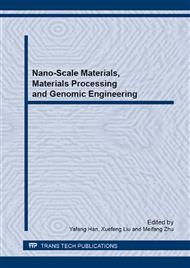p.28
p.32
p.36
p.44
p.48
p.54
p.59
p.64
p.70
Effect of Aging Temperature on Microstructure and Hardness of CoCrFeNiTi0.5 High Entropy Alloy
Abstract:
A bulk casting ingot (Ø70 × 150mm) of CoCrFeNiTi0.5 high entropy alloy was prepared by vacuum medium frequency induction melting. The samples from the ingot were aged for 12h in the temperature range of 900-1100°C and then quenched in water to investigate the effect of aging temperature on the microstructure and hardness of CoCrFeNiTi0.5 alloy. The crystalline structure of as-cast CoCrFeNiTi0.5 alloy consisted of the principal face-centered cubic (FCC) dendrite phase plus (Ni, Ti)-rich R phase, (Fe, Cr)-rich σ phase, (Co, Ti)-rich Laves phase within the inter-dendrite area. The dendrite contained approximately equivalent amount of Co, Cr, Fe, Ni and a smaller amount of Ti element. After aging treatment in the temperature range of 900-1000°C, the (Co, Ti)-rich phase disappeared while the amount of (Ni, Ti)-rich phase and (Fe, Cr)-rich phase increased. But the volume fraction of FCC dendrite phase increased and the intermetallic phases decreased after aging at 1100°C. The micro-hardness and the macro-hardness of the as-cast CoCrFeNiTi0.5 alloy were HV616.8 and HRC52, respectively. After heat treatment at 1000°C, the micro-hardness and macro-hardness decreased from HV616.8 to HV386.8 and from HRC52 to HRC42.7, respectively.
Info:
Periodical:
Pages:
48-53
Citation:
Online since:
April 2014
Authors:
Keywords:
Price:
Сopyright:
© 2014 Trans Tech Publications Ltd. All Rights Reserved
Share:
Citation:


